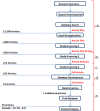Contamination of groundwater systems in the US and Canada by enteric pathogens, 1990-2013: a review and pooled-analysis
- PMID: 24806545
- PMCID: PMC4012953
- DOI: 10.1371/journal.pone.0093301
Contamination of groundwater systems in the US and Canada by enteric pathogens, 1990-2013: a review and pooled-analysis
Abstract
Background: Up to 150 million North Americans currently use a groundwater system as their principal drinking water source. These systems are a potential source of exposure to enteric pathogens, contributing to the burden of waterborne disease. Waterborne disease outbreaks have been associated with US and Canadian groundwater systems over the past two decades. However, to date, this literature has not been reviewed in a comprehensive manner.
Methods and principal findings: A combined review and pooled-analysis approach was used to investigate groundwater contamination in Canada and the US from 1990 to 2013; fifty-five studies met eligibility criteria. Four study types were identified. It was found that study location affects study design, sample rate and studied pathogen category. Approximately 15% (316/2210) of samples from Canadian and US groundwater sources were positive for enteric pathogens, with no difference observed based on system type. Knowledge gaps exist, particularly in exposure assessment for attributing disease to groundwater supplies. Furthermore, there is a lack of consistency in risk factor reporting (local hydrogeology, well type, well use, etc). The widespread use of fecal indicator organisms in reported studies does not inform the assessment of human health risks associated with groundwater supplies.
Conclusions: This review illustrates how groundwater study design and location are critical for subsequent data interpretation and use. Knowledge gaps exist related to data on bacterial, viral and protozoan pathogen prevalence in Canadian and US groundwater systems, as well as a need for standardized approaches for reporting study design and results. Fecal indicators are examined as a surrogate for health risk assessments; caution is advised in their widespread use. Study findings may be useful during suspected waterborne outbreaks linked with a groundwater supply to identify the likely etiological agent and potential transport pathway.
Conflict of interest statement
Figures
References
-
- Environment Canada (2013) Hydrology of Canada. Available: http://www.ec.gc.ca/rhc-wsc/default.asp?lang=En&n=E94719C8-1 Accessed: 2014 April 4.
-
- Sharpe D, Russell H, Grasby S (2007) Hydrogeological regions of Canada. Available: http://www.nrcan.gc.ca/sites/www.nrcan.gc.ca.earth-sciences/files/pdf/gm... Accessed: 2014 April 4.
-
- Robertson W, Neil D (2001) Microbiological quality of drinking water in Canada: An overview of the Health Canada programme. In Mahmound M and van Everdingen R (eds) 2001 An Earth Odyssey, Proceedings of the 54th Canadian Geotechnical Conference, September 16–19, 2001, Calgary, AB, Canada, Bitech, Richmond, BC, Canada, 45–49.
-
- Corkal DR, Schutzman WC, Hilliard CR (2004) Rural Water Safety from the Source to the On-Farm Tap. Journal of Toxicology and Environmental Health, Part A. 67: 1619–1642. - PubMed
Publication types
MeSH terms
LinkOut - more resources
Full Text Sources
Other Literature Sources
Miscellaneous


